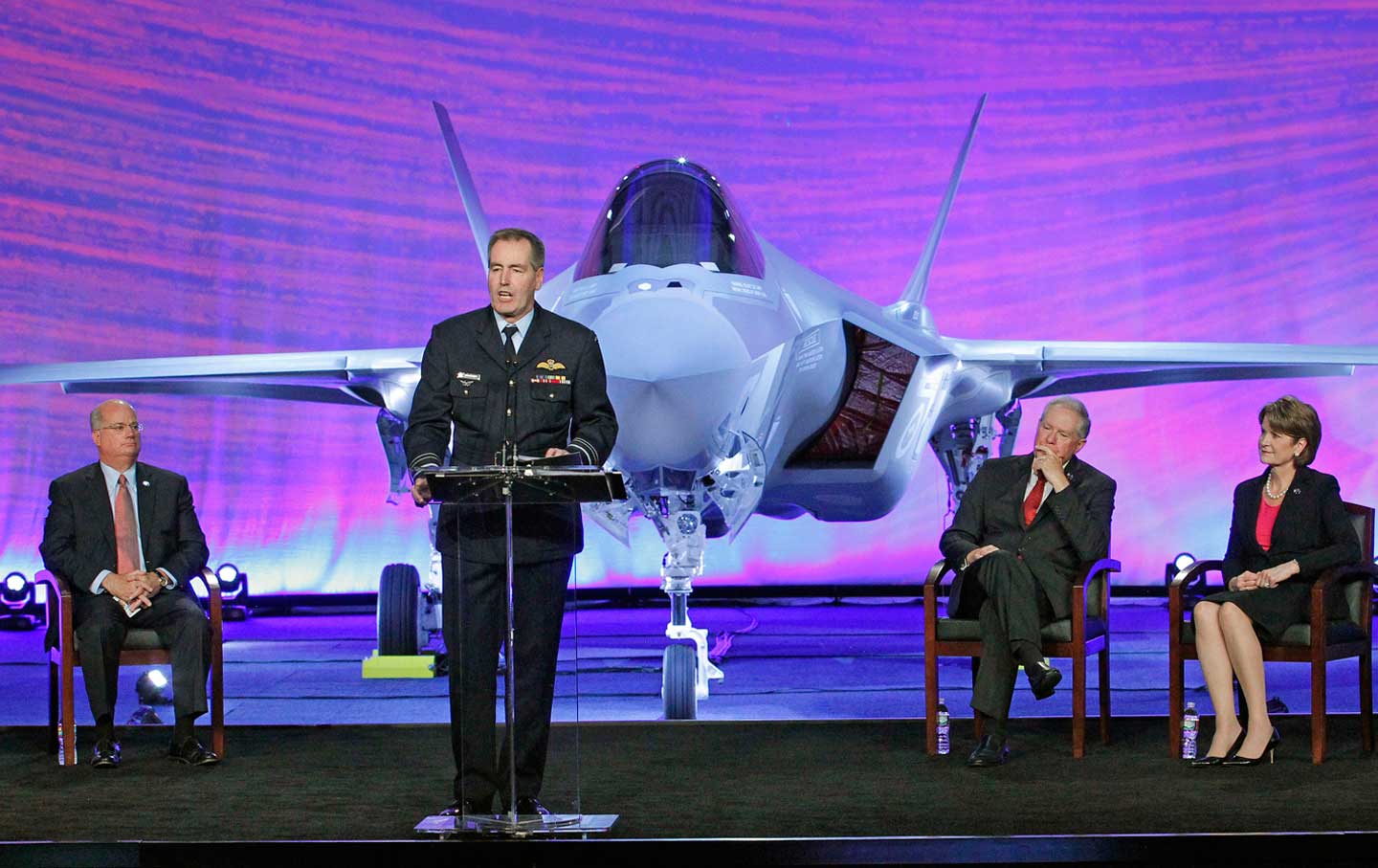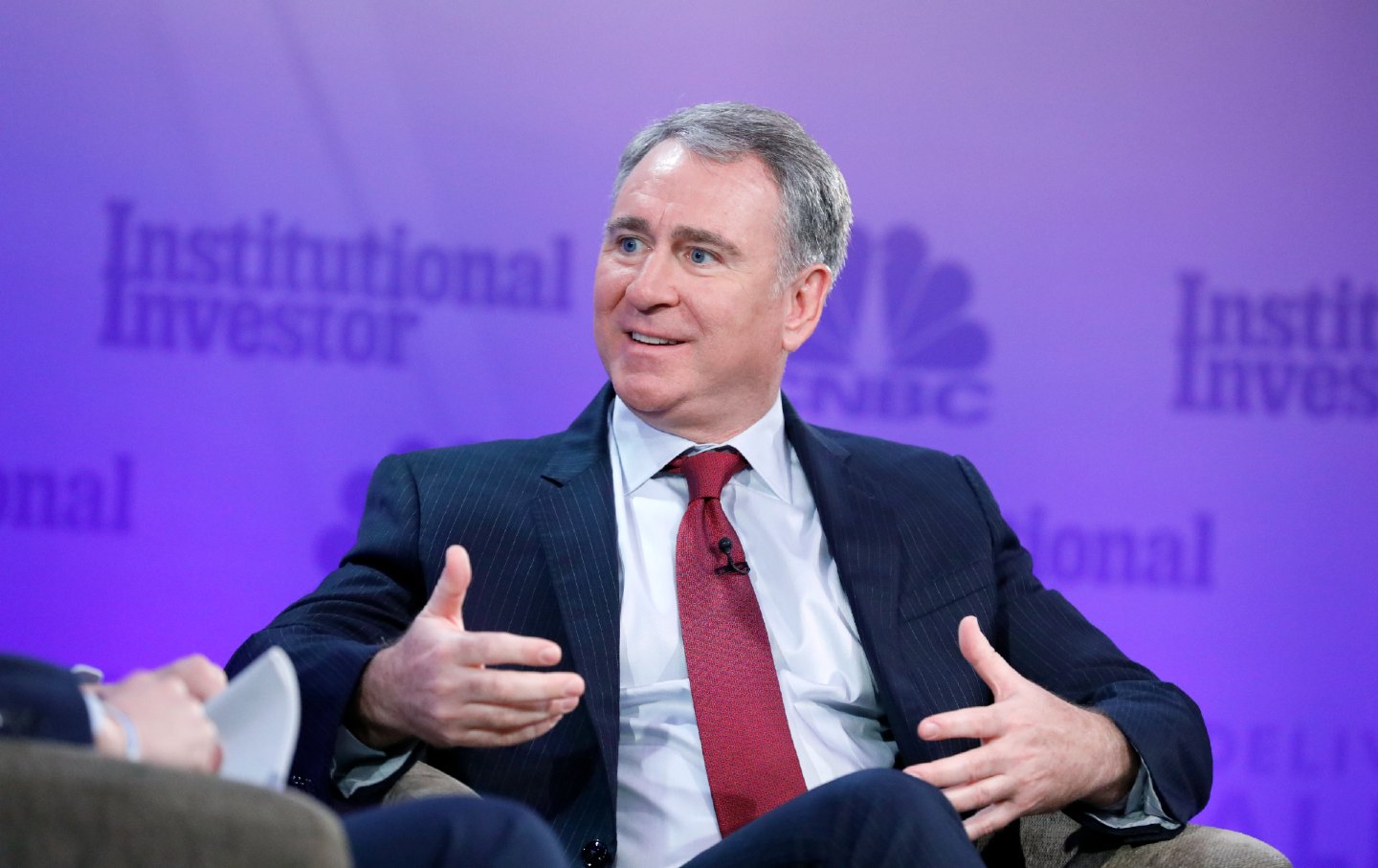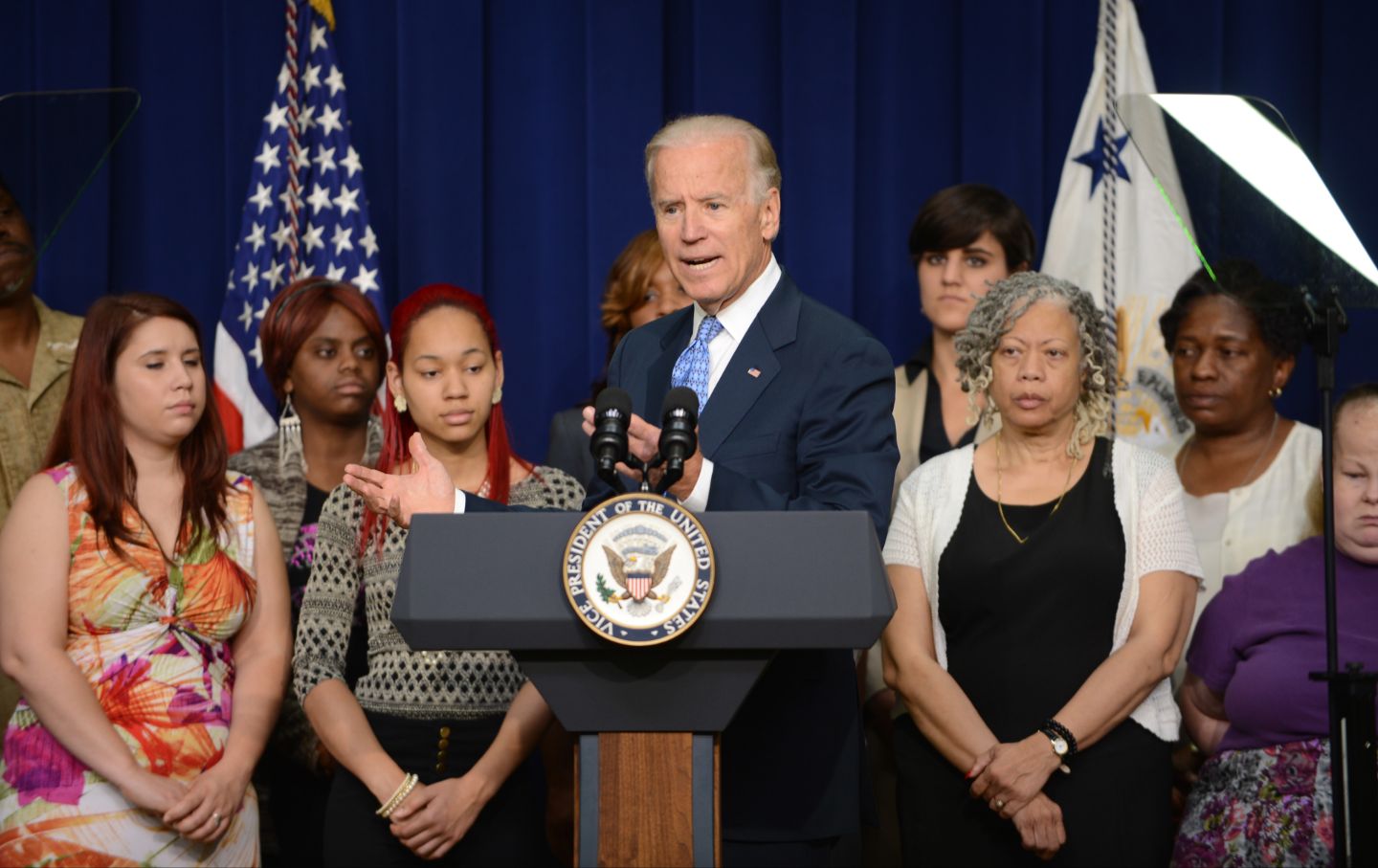Military Spending Isn’t the Economic Galvanizer You Think it Is
The opportunity costs of throwing endless trillions of dollars at the military means far less is invested in other crucial American needs

An F-35 stealth jet built for the Royal Australian Air Force is presented at Lockheed Martin in Fort Worth, Tex.
(Paul Moseley / Fort Worth Star-Telegram via AP Photo)This article originally appeared at TomDispatch.com. To stay on top of important articles like these, sign up to receive the latest updates from TomDispatch.com.
Joe Biden wants you to believe that spending money on weapons is good for the economy. That tired old myth—regularly repeated by the political leaders of both parties—could help create an even more militarized economy that could threaten our peace and prosperity for decades to come. Any short-term gains from pumping in more arms spending will be more than offset by the long-term damage caused by crowding out new industries and innovations, while vacuuming up funds needed to address other urgent national priorities.
The Biden administration’s sales pitch for the purported benefits of military outlays began in earnest last October, when the president gave a rare Oval Office address to promote a $106-billion emergency allocation that included tens of billions of dollars of weaponry for Ukraine, Israel, and Taiwan. MAGA Republicans in Congress had been blocking the funding from going forward and the White House was searching for a new argument to win them over. The president and his advisers settled on an answer that could just as easily have come out of the mouth of Donald Trump: jobs, jobs, jobs. As Joe Biden put it:
We send Ukraine equipment sitting in our stockpiles. And when we use the money allocated by Congress, we use it to replenish our own stores…equipment that defends America and is made in America: Patriot missiles for air defense batteries made in Arizona; artillery shells manufactured in 12 states across the country—in Pennsylvania, Ohio, Texas; and so much more.
It should be noted that two of the four states he singled out (Arizona and Pennsylvania) are swing states crucial to his reelection bid, while the other two are red states with Republican senators he’s been trying to win over to vote for another round of military aid to Ukraine.
Lest you think that Biden’s economic pitch for such aid was a one-off event, Politico reported that, in the wake of his Oval Office speech, administration officials were distributing talking points to members of Congress touting the economic benefits of such aid. Politico dubbed this approach “Bombenomics.” Lobbyists for the administration even handed out a map purporting to show how much money such assistance to Ukraine would be distributed to each of the 50 states. And that, by the way, is a tactic companies like Lockheed Martin routinely use to promote the continued funding of costly, flawed weapons systems like the F-35 fighter jet. Still, it should be troubling to see the White House stooping to the same tactics.
Yes, it’s important to provide Ukraine with the necessary equipment and munitions to defend itself from Russia’s grim invasion, but the case should be made on the merits, not through exaggerated accounts about the economic impact of doing so. Otherwise, the military-industrial complex will have yet another never-ending claim on our scarce national resources.
Military Keynesianism and Cold War Fallacies
The official story about military spending and the economy starts like this: the massive buildup for World War II got America out of the Great Depression, sparked the development of key civilian technologies (from computers to the internet), and created a steady flow of well-paying manufacturing jobs that were part of the backbone of America’s industrial economy.
There is indeed a grain of truth in each of those assertions, but they all ignore one key fact: the opportunity costs of throwing endless trillions of dollars at the military means far less is invested in other crucial American needs, ranging from housing and education to public health and environmental protection. Yes, military spending did indeed help America recover from the Great Depression but not because it was military spending. It helped because it was spending, period. Any kind of spending at the levels devoted to fighting World War II would have revived the economy. While in that era, such military spending was certainly a necessity, today similar spending is more a question of (corporate) politics and priorities than of economics.
In these years Pentagon spending has soared and the defense budget continues to head toward an annual trillion-dollar mark, while the prospects of tens of millions of Americans have plummeted. More than 140 million of us now fall into poor or low-income categories, including one out of every six children. More than 44 million of us suffer from hunger in any given year. An estimated 183,000 Americans died of poverty-related causes in 2019, more than from homicide, gun violence, diabetes, or obesity. Meanwhile, ever more Americans are living on the streets or in shelters as homeless people hit a record 650,000 in 2022.
Perhaps most shockingly, the United States now has the lowest life expectancy of any industrialized country, even as the International Institute for Strategic Studies reports that it now accounts for 40 percent of the world’s—yes, the whole world’s!—military spending. That’s four times more than its closest rival, China. In fact, it’s more than the next 15 countries combined, many of which are US allies. It’s long past time for a reckoning about what kinds of investments truly make Americans safe and economically secure—a bloated military budget or those aimed at meeting people’s basic needs.
What will it take to get Washington to invest in addressing non-military needs at the levels routinely lavished on the Pentagon? For that, we would need presidential leadership and a new, more forward-looking Congress. That’s a tough, long-term goal to reach, but well worth pursuing. If a shift in budget priorities were to be implemented in Washington, the resulting spending could, for instance, create anywhere from 9 percent more jobs for wind and solar energy production to three times as many jobs in education.
As for the much-touted spinoffs from military research, investing directly in civilian activities rather than relying on a spillover from Pentagon spending would produce significantly more useful technologies far more quickly. In fact, for the past few decades, the civilian sector of the economy has been far nimbler and more innovative than Pentagon-funded initiatives, so—don’t be surprised—military spinoffs have greatly diminished. Instead, the Pentagon is desperately seeking to lure high-tech companies and talent back into its orbit, a gambit which, if successful, is likely to undermine the nation’s ability to create useful products that could push the civilian sector forward. Companies and workers who might otherwise be involved in developing vaccines, producing environmentally friendly technologies, or finding new sources of green energy will instead be put to work building a new generation of deadly weapons.
Diminishing Returns
In recent years, the Pentagon budget has approached its highest level since World War II: $886 billion and counting. That’s hundreds of billions more than was spent in the peak year of the Vietnam War or at the height of the Cold War. Nonetheless, the actual number of jobs in weapons manufacturing has plummeted dramatically from three million in the mid-1980s to 1.1 million now. Of course, a million jobs is nothing to sneeze at, but the downward trend in arms-related employment is likely to continue as automation and outsourcing grow. The process of reducing arms industry jobs will be accelerated by a greater reliance on software over hardware in the development of new weapons systems that incorporate artificial intelligence. Given the focus on emerging technologies, assembly line jobs will be reduced, while the number of scientists and engineers involved in weapons-related work will only grow.
In addition, as the journalist Taylor Barnes has pointed out, the arms industry jobs that do remain are likely to pay significantly less than in the past, as unionization rates at the major contractors continue to fall precipitously, while two-tier union contracts deny incoming workers the kind of pay and benefits their predecessors enjoyed. To cite two examples: in 1971, 69 percent of Lockheed Martin workers were unionized, while in 2022 that number was 19 percent; at Northrop Grumman today, a mere 4 percent of its employees are unionized. The very idea that weapons production provides high-paying manufacturing jobs with good benefits is rapidly becoming a thing of the past.
More and better-paying jobs could be created by directing more spending to domestic needs, but that would require a dramatic change in the politics and composition of Congress.
Popular
“swipe left below to view more authors”Swipe →The Military Is Not an “Anti-Poverty Program”
Members of Congress and the Washington elite continue to argue that the US military is this country’s most effective anti-poverty program. While the pay, benefits, training, and educational funding available to members of that military have certainly helped some of them improve their lot, that’s hardly the full picture. The potential downside of military service puts the value of any financial benefits in grim perspective.
Many veterans of America’s disastrous post-9/11 wars, after all, risked their physical and mental health, not to speak of their lives, during their time in the military. After all, 40 percent of veterans of the Iraq and Afghan wars have reported service-related disabilities. Physical and mental health problems suffered by veterans range from lost limbs to traumatic brain injuries to post-traumatic stress syndrome. They have also been at greater risk of homelessness than the population as a whole. Most tragically, four times as many veterans have committed suicide as the number of military personnel killed by enemy forces in any of the US wars of this century.
The toll of such disastrous conflicts on veterans is one of many reasons that war should be the exception, not the rule, in US foreign policy.
And in that context, there can be little doubt that the best way to fight poverty is by doing so directly, not as a side-effect of building an increasingly militarized society. If, to get a leg up in life, people need education and training, it should be provided to civilians and veterans alike.
Trade-Offs
Federal efforts to address the problems outlined above have been hamstrung by a combination of overspending on the Pentagon and the unwillingness of Congress to more seriously tax wealthy Americans to address poverty and inequality. (After all, the wealthiest 1 percent of us are now cumulatively worth more than the 291 million of us in the “bottom” 90 percent, which represents a massive redistribution of wealth in the last half-century.)
The tradeoffs are stark. The Pentagon’s annual budget is significantly more than 20 times the $37 billion the government now invests annually in reducing greenhouse gas emissions as part of the Inflation Reduction Act. Meanwhile, spending on weapons production and research alone is more than eight times as high. The Pentagon puts out more each year for one combat aircraft—the overpriced, underperforming F-35—than the entire budget of the Centers for Disease Control and Prevention. Meanwhile, one $13 billion aircraft carrier costs more to produce than the annual budget of the Environmental Protection Agency. Similarly, in 2020, Lockheed Martin alone received $75 billion in federal contracts and that’s more than the budgets of the State Department and the Agency for International Development combined. In other words, the sum total of that company’s annual contracts adds up to the equivalent of the entire US budget for diplomacy.
Simply shifting funds from the Pentagon to domestic programs wouldn’t, of course, be a magical solution to all of America’s economic problems. Just to achieve such a shift in the first place would, of course, be a major political undertaking and the funds being shifted would have to be spent effectively. Furthermore, even cutting the Pentagon budget in half wouldn’t be enough to take into account all of this country’s unmet needs. That would require a comprehensive package, including not just a change in budget priorities but an increase in federal revenues and a crackdown on waste, fraud, and abuse in the outlay of government loans and grants. It would also require the kind of attention and focus now reserved for planning to fund the military.
One comprehensive plan for remaking the economy to better serve all Americans is the moral budget of the Poor People’s Campaign, a national movement of low-income people inspired by the 1968 initiative of the same name spearheaded by the Rev. Martin Luther King Jr., before his assassination that April 4th. Its central issues are promoting racial justice, ending poverty, opposing militarism, and supporting environmental restoration. Its moral budget proposes investing more than $1.2 trillion in domestic needs, drawn from both cuts to Pentagon spending and increases in tax revenues from wealthy individuals and corporations. Achieving such a shift in American priorities is, at best, undoubtedly a long-term undertaking, but it does offer a better path forward than continuing to neglect basic needs to feed the war machine.
If current trends continue, the military economy will only keep on growing at the expense of so much else we need as a society, exacerbating inequality, stifling innovation, and perpetuating a policy of endless war. We can’t allow the illusion—and it is an illusion!—of military-fueled prosperity to allow us to neglect the needs of tens of millions of people or to hinder our ability to envision the kind of world we want to build for future generations. The next time you hear a politician, a Pentagon bureaucrat, or a corporate functionary tell you about the economic wonders of massive military budgets, don’t buy the hype.
More from The Nation

Why Bidenomics Was Such a Bust Why Bidenomics Was Such a Bust
A large majority of voters gave the Biden administration a failing grade on the economy. For the sake of future policy battles, it is worthwhile to try to understand their reasons...

Hickey Freeman's Next Chapter Hickey Freeman's Next Chapter
This factory in upstate New York is a testament to the lasting legacy and future of the modern labor movement.

If You Don’t Know Who Ken Griffin Is, You Should If You Don’t Know Who Ken Griffin Is, You Should
How the press keeps us in the dark about the new Gilded Age.

Millions of Workers Are Due More Overtime Pay. Will They Get It? Millions of Workers Are Due More Overtime Pay. Will They Get It?
New regulations are designed to expand the number of employees entitled to overtime. But the conservative courts have other ideas.

Ballet Dancers’ Next Move: Union Organizing Ballet Dancers’ Next Move: Union Organizing
Contract negotiations have brought higher pensions, mandated rest times, and increased wages for a job that requires intense schedules and years of training.

How Can We Wean Ourselves Off Our Country’s Military Dependency? How Can We Wean Ourselves Off Our Country’s Military Dependency?
Moving resources and skills and jobs from the military-industrial complex to civilian sectors is a big project. But it could start in your own community.


